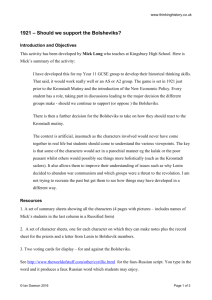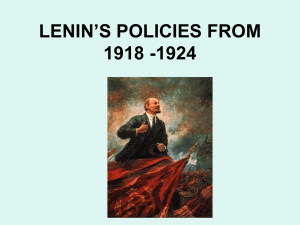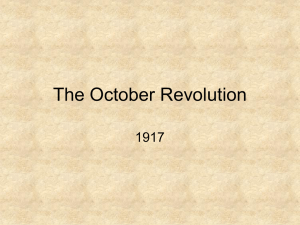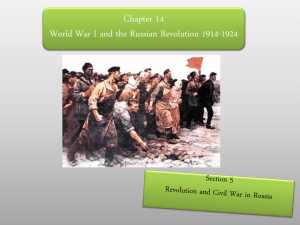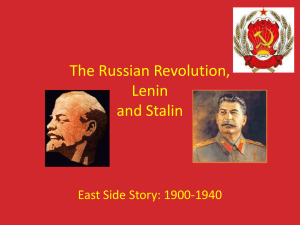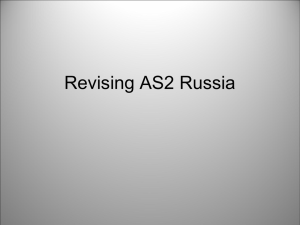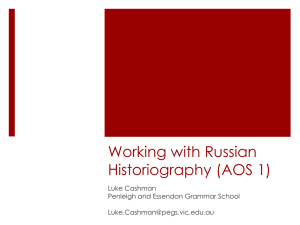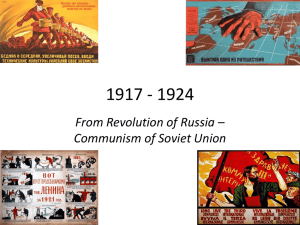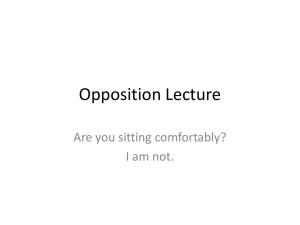War Communism and NEP PowerPoint
advertisement
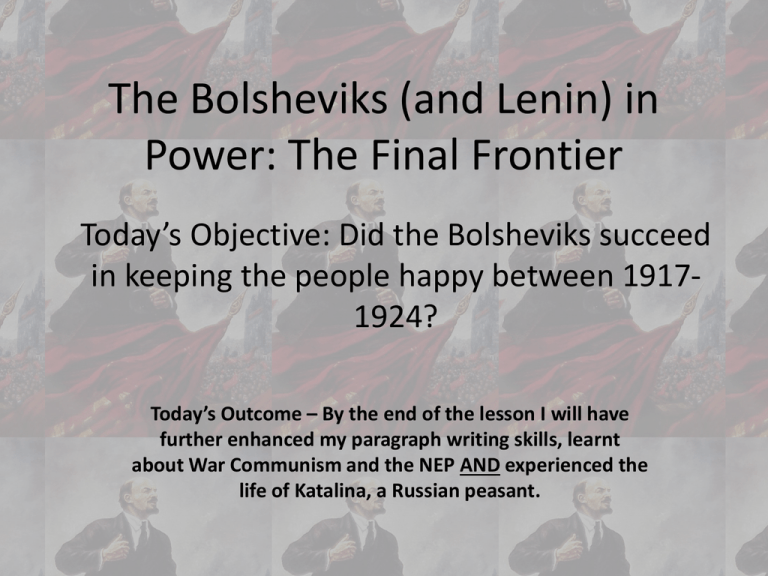
The Bolsheviks (and Lenin) in Power: The Final Frontier Today’s Objective: Did the Bolsheviks succeed in keeping the people happy between 19171924? Today’s Outcome – By the end of the lesson I will have further enhanced my paragraph writing skills, learnt about War Communism and the NEP AND experienced the life of Katalina, a Russian peasant. Starter: How effectively did the Bolsheviks rule Russia initially, in comparison to the Tsar? You have 2 model paragraphs that answer this question, but they have been muddled up. You need to sort out the correct order of them, stick them into your books in the correct order and then colour code the PEEA (Point – Evidence using knowledge – Evidence using source – Analysis) and underline the evaluation of the source/s. The Bolsheviks began their rule very differently to the Tsar’s reign, as they immediately kept their promises and listened to the people’s needs. The Bolshevik decrees were passed in November and December of 1917 and were designed to keep the peasants and workers happy, make life easier for the Russian people, yet also allow the Bolsheviks to maintain a strict degree of control. For example, they reduced the working day to 8 hours and the working week to 48 hours. They additionally made divorce easier and allowed marriages to take place without a priest. The impact of these decrees was commented on by a diplomat (in his diary) living in Russia at the time. ‘We are living in a madhouse, and in the last few days there has been an avalanche of decrees... A law is being made to take away even their children from the bourgeois... In this way differences in education, which are contrary to the sacred dogma of equality will be avoided, by degrading them all to the same level that is to say that lowest level of all.’ This source suggests that the Bolsheviks were changing society rapidly; however, he is unsupportive of these changes. As a foreign diplomat he would not be used to a communist system and clearly did not approve of some of the socialist policies adopted by the Bolsheviks. In this sense the source does not present an impartial view and needs to be treated with caution. An alternative opinion is presented in this Bolshevik source. ‘Every genuinely democratic power must, in the domain of education, in a country where illiteracy and ignorance reign supreme, make its first aim in the struggle against this darkness. It must acquire in the shortest time universal literacy...it must introduce universal, obligatory, and free tuition for all.’ Although clearly partial to the Bolsheviks, this source shows their determination to make Russia a more equal society and give the people, in particular the peasants what they wanted. This evidence does suggest that the Bolsheviks initial style of rule was effective in comparison to the Tsar’s, as they were prepared to listen to the people’s complaints of inequality and illiteracy and did keep their promises (despite drastic changes) by issuing their decrees which addressed some of the problems facing the people. Additionally, the Bolsheviks ruled Russia effectively initially in comparison to the Tsar because they ended the war which had been plaguing Russian society. Lenin put Trotsky in charge of negotiating a peace treaty with Germany and Lenin was determined to make this happen, as it had been one of his promises in the April Thesis. The Treaty of Brest Litovsk was signed in March 1918 and its terms were harsh. For example, Russia lost 34% of its population, 32% of its agricultural land and 54% of its industry. It did however demonstrate Lenin’s single minded leadership and his skill as a politician, as he hoped that Russia would gain this back when the allies defeated Germany. He recognised that the terms were severe, but also recognised that the Russian people were exhausted with the war effort, he therefore, listened to their needs, unlike the Tsar. The following source from a German soldier demonstrates how harsh the treaty was. ‘The final peace treaty has been signed with Russia. Our conditions are hard and severe, but our quite exceptional victories entitle us to demand these…in the last week we have captured the following men and items of equipment: 6,800 officers, 54,000 men, 2,400 guns, 5,000 machine-guns, 8,000 railway trucks, 8,000 locomotives, 128,000 rifles and 2 million rounds of artillery ammunition. Yes, there is still some justice left.’ This source, whilst presenting a clearly one sided view, favorable to Germany, is still useful for indicating how hard it was for the Bolsheviks to sign this treaty and shows how determined Lenin must have been to stick to his promise of peace. It is therefore clear that the Bolsheviks initial rule contrasted considerably to the Tsar’s rule and despite the Treaty of Brest Litovsk not necessarily being viewed as successful, due to its harshness, it did demonstrate Lenin’s willingness to address the people’s needs, as the First World War had drained Russia economically and physically. Recap from last lesson • What had Lenin done since seizing power and what events had occurred in the period up to 1921? 1. Decrees 2. Holding elections and then closing down the Constituent Assembly 3. Signing Treaty of Brest Litovsk 4. Outbreak of Civil War 5. Red Terror Lenin’s final Frontier: War Communism and the NEP War Communism This was the name of the harsh economic measures that the Bolsheviks adopted during the Civil War. It’s aims were (1) to put communist theories into practice by sharing out the wealth of the country among the people and (2) to help with the Civil War by keeping towns and the Red Army supplied with food and weapons. What did it involve? • All large factories were taken over by the government • Discipline for workers was strict and strikers could be shot • Peasants had to hand over surplus food to the government. If they didn’t they could be shot • Food was rationed • Free enterprise became illegal Consequences of War Communism It caused terrible hardship. Peasants refused to cooperate in producing more food because it was just being taken away from them. This led to food shortages, which along with bad weather in 192021 caused a terrible famine. Some estimates suggest that 7 million Russian people died. There were even reports of cannibalism. Summary of War Communism 1. It was the harsh economic measures that the Bolsheviks adopted during the Civil War. 2. Its aims were to put communist theories into practice by sharing out the wealth of the country among the people and to help with the Civil War by keeping towns and the Red Army supplied with food and weapons. 3. The peasants were treated really harshly as a result of this policy, for example, they had to hand over surplus grain and if they didn’t they could be shot. Whether you were an efficient peasant or a lazy peasant, you were both left with the same – it took away incentives. 4. It also effected the workers as all large factories were taken over by the government and discipline for workers was very strict. Striking workers could be shot. 5. As a result of the peasants rebelling and not cooperating with the Bolsheviks (plus bad weather) there was a famine in 1921 and it is estimated that 7 million people died. Kronstadt Naval Mutiny In February 1921, these harsh policies sparked a mutiny at Kronstadt naval base. The sailors at Kronstadt had been supporters of Lenin and the Bolsheviks, so their mutiny was a significant sign to Lenin that he had upset the people with his harsh policy. The Red Army crushed the mutiny and thousands of the sailors were killed, but Lenin did stop and review his policies as a result of this event. NEP (New Economic Policy) • In March 1921 Lenin announced some startling new policies which he called the NEP. It brought back a little bit of capitalism (opposite to communism) for some sections of Russian society. • The government now only took 50% of surplus grain leaving the peasant with the other half to eat and sell for money - this rewarded hard working peasants (see picture). Consequences of NEP • It created stability and people were won over to the Bolshevik cause and Lenin used this popularity to enable him to crush any existing opposition. • It did however create internal opposition within the Bolshevik Party as some members felt it was a betrayal of communism. Lenin however persevered with the policy, claiming it was only temporary to stabilise the country. • By 1925 there is evidence to suggest it was working, as food production rose steeply. Poor, starving old Russia, Russia of primitive lighting and the meal of a crust of black bread, is going to be covered by a network of electric power stations. The NEP will transform the Russian economy and rebuild a broken nation. The future is endless and beautiful. Bukharin, a leading Bolshevik , speaking in 1922 Summary of the New Economic Policy 1. The Civil War had ended, but there was growing discontent in the cities and the mutiny at the Kronstadt naval base signalled that a change in policy (from War Communism) was needed. 2. To improve the conditions, Lenin reintroduced the opportunities for peasants to make profits, in order to give them the incentive to grow more. 3. The government now only took 50% of surplus grain, leaving the peasants with the other half to eat and sell for money (this benefitted the peasants that worked hard). 4. NEP markets sprung up around cities selling a variety of goods. 5. It created stability in society and people were won over to the Bolshevik cause. 6. Lenin used this opportunity to crush any remaining opposition. 7. However, some Bolsheviks opposed the policy, seeing it as a betrayal of communism. Lenin however was determined to carry the policy through and did so (it was still in place when he died). Death of Lenin • Lenin suffered several strokes in 1922 and 1923 which led to his death in January 1924. • Would he have pursued the NEP? We’ll never know! A summary of life under the Tsar, Provisional Government and The Bolsheviks • To get an idea about how Russian people’s lives changed from the Tsar’s reign to the death of Lenin, we need to look at the personal stories of some Russian people, who lived throughout this period. • Meet Katalina... How far did life change for Russian Peasants from 1905-1924? Under the NEP however, my life... Katalina, a hard working peasant During the Civil War I suffered terribly due to the policy of War Communism... When the Bolsheviks came to power and announced their decrees I felt a great deal of hope because... My life in 1905 was... During the First World War, my family and I felt the hardships because... However, I did not benefit under the Provisional Government, after the Tsar had abdicated because... How far did life change for the workers between 19051924? Under the NEP my life... My life in 1905 was... During the Civil War I suffered terribly due to the policy of War Communism... During the First World War, my family and I felt the hardships because... When the Bolsheviks came to power and announced their decrees I felt a great deal of hope because... However, I did not benefit under the Provisional Government, after the Tsar had abdicated because...
